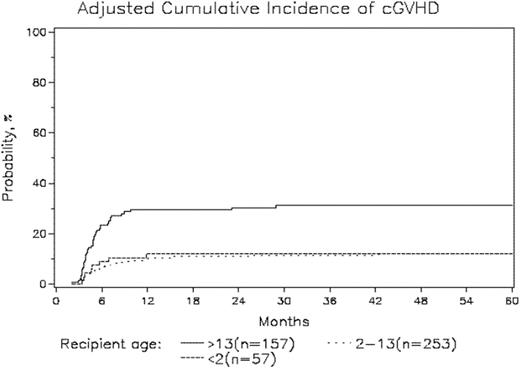Abstract
Introduction: In adult HLA matched sibling donor (MSD) hematopoietic cell transplantation, both recipient and donor age have been shown to be a risk factors for graft versus host disease (GVHD). While it is widely recognized that pediatric patients are at lower risk for GVHD than adults, the importance of age within the pediatric age group in MSD transplantation has not been examined. We, therefore, assessed the impact of age on GVHD risk after MSD bone marrow transplantation (BMT) in 477 pediatric patients with acute leukemia.
Methods: This is a Center for International Blood and Marrow Transplantation registry study. Patients younger than 18 years with acute myeloid leukemia (AML) or acute lymphoblastic leukemia (ALL) in 1st or 2nd complete remission (CR), who received myeloablative conditioining, T cell-replete HLA MSD BMT and calcineurin inhibitor based GVHD prophylaxis between 2000-2013 were included. Patients who received a lymphocyte depleting antibody were excluded. Because donor and recipient ages were highly correlated, their effects could not be independently assessed. We, therefore, assessed only recipient age.
Results: The transplants were drawn from 101 centers. The median age of the recipients was 10.1 years. 21% had ALL in 1st CR, 24% ALL in 2nd CR, 47% AML in 1st CR and 8% AML in 2nd CR. 73% received cyclosporine and Methotrexate for GVHD prophylaxis. In a preliminary model, using grade 3-4 acute GVHD as the endpoint, we identified two cut points, 2 years and 13 years using the likelihood ratio test. In all final models, three age groups were used to define recipient age: < 2 years (n=60), 2 to 12.99 (n=255) years and 13-17.99 years (n=162). The cumulative incidence of grade 2-4 acute GVHD at 100 days post-transplant was 19% (95% confidence interval, CI, 16-23%); 24% (95% CI 14-35%), 13% (95% CI 9-18%) and 28% (95% CI 21-35%) for recipients <2 years, 2-12.99 years, and 13-17.99 years of age, respectively (p-value=0.001). For grade 3-4 acute GVHD, the cumulative incidence estimate at 100 days was 8% (95% CI 3-17%), 3% (95% CI 1-6%) and 14% (95% CI 9-20%) (p <0.001) and the cumulative incidence estimate for chronic GVHD at 1 year was 15% (95% CI 7-25%), 10% (95% CI 7-14%) and 27% (95% CI 20-34%) (p <0.001) for recipients <2 years, 2-12.99 years, and 13-17.99 years of age, respectively (Figures 1-3). In the multivariate analyses, using age 13-17.99 as the baseline and .01 as the threshold for significance, age 2-12.99 years (HR 0.43, 95% CI 0.26-0.71, p=0.001), but not age < 2 years (HR 0.59, 95% CI 0.3-1.18, p=0.14), was associated with a lower risk for grade 2-4 acute GVHD (after adjustment for GVHD prophylaxis, performance score and year of transplant). For grade 3-4 acute GVHD, again age 2-12.99 years (HR 0.24, 95% CI 0.1-0.56, p=0.001), but not age < 2 years (HR 0.75, 95% CI 0.29-1.94, p=0.55), was associated with a lower risk, after adjustment for year of transplant. For chronic GVHD (after adjustment for donor-recipient birth order, and GVHD prophylaxis), age 2-12.99 years (HR 0.32, 95% CI 0.19-0.54, p<0.001) was associated with lower risk; the effect was similar in age < 2 years, but did not reach significance (HR 0.36, 95% CI 0.16-0.82, p=0.016). Year of transplant had a strong effect on acute, but not chronic GVHD. Its effect did not appear to be mediated by changes in GVHD prophylaxis. Using 2000-2004 as the baseline, the HR for grade 2-4 acute GVHD was 0.38 (95% CI 0.20-0.64, p=0.0006) and 0.28 (95% CI 0.13-0.59, p=0.0008) for 2005-2008 and 2009-2013, respectively. For grade 3-4 acute GVHD, they were 0.23 (95% CI 0.08-0.65, p=0.0057) and 0.23 (95% CI 0.07-0.78, p=0.0183) for these periods, respectively. There was no difference in overall survival, leukemia-free survival or transplant related mortality between the age groups.
Conclusion:
Our results indicate that children 2-12.99 years have a lower risk for acute and chronic GVHD than those 13 years and older. Children less than 2 years may also have a reduced risk for chronic GVHD, but this possibility needs to be re-examined in a larger sample. It is plausible that pubertal changes underlie the rise in risk for GVHD during adolescence. An important limitation of our study was that we were unable to examine the impact of donor age because of the strong correlation between donor and recipient age. A study with a larger sample is also needed to further investigate this matter.
No relevant conflicts of interest to declare.
Author notes
Asterisk with author names denotes non-ASH members.




This feature is available to Subscribers Only
Sign In or Create an Account Close Modal